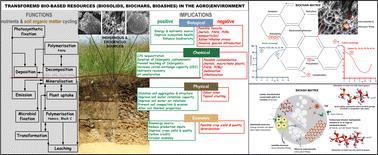Our official English website, www.x-mol.net, welcomes your
feedback! (Note: you will need to create a separate account there.)
Bio-based resources: systemic & circular solutions for (agro)environmental services
RSC Advances ( IF 3.9 ) Pub Date : 2024-07-25 , DOI: 10.1039/d4ra03506b Gabrijel Ondrasek 1 , Cristian Meriño-Gergichevich 2, 3, 4, 5 , Carlos Manterola-Barroso 2, 3, 4, 6 , Alex Seguel Fuentealba 7 , Sebastián Meier Romero 8, 9 , Radovan Savić 10 , Sarvamangala S Cholin 11, 12 , Jelena Horvatinec 1
RSC Advances ( IF 3.9 ) Pub Date : 2024-07-25 , DOI: 10.1039/d4ra03506b Gabrijel Ondrasek 1 , Cristian Meriño-Gergichevich 2, 3, 4, 5 , Carlos Manterola-Barroso 2, 3, 4, 6 , Alex Seguel Fuentealba 7 , Sebastián Meier Romero 8, 9 , Radovan Savić 10 , Sarvamangala S Cholin 11, 12 , Jelena Horvatinec 1
Affiliation

|
The global promotion of decarbonisation through the circular solutions and (re)use of bio-based resources (BBR), i.e. waste streams, notably from the agricultural, forest and municipal sectors has steadily increased in recent decades. Among the transformative solutions offered by BBR, biosolids (BS), biochars (BC), and bioashes (BA) specifically attract scientific attention due to their highly complex organo-mineral matrices, which present significant potential for recovery in the agro-/forest-ecosystems. These materials enhance various soil (i) chemical (pH, macro/micro nutrient concentrations, organic matter content), (ii) physical (porosity, water–air relations, compaction) or (iii) microbial (diversity, activity) properties. Furthermore, some of transformed BBR contribute to a multitude of environmental services such as the remediation of contaminated sites and wastewater treatment, employing cost-effective and eco-friendly approaches that align with circular economy/waste management principles, ultimately contributing to climate change mitigation. However, several challenges impede the widespread utilization/transformation of BBR, including technological limitations in processing and application, concerns about contamination (e.g., PAHs, PCBs, micro/nano plastics present in BS), toxicity issues (e.g., heavy metals in BA or nanoparticles in BC), and regulatory constraints (e.g., non-uniform regulations governing the reuse of BA and BS). Addressing these challenges demands an interdisciplinary and intersectoral approach to fully unlock the potential of BBR in sustainable decarbonisation efforts.
中文翻译:

生物基资源:(农业)环境服务的系统和循环解决方案
近几十年来,全球通过循环解决方案和生物基资源(BBR)(即废物流,特别是来自农业、林业和市政部门的废物流)(再)利用来促进脱碳,这一活动稳步增加。在 BBR 提供的变革性解决方案中,生物固体 (BS)、生物炭 (BC) 和生物灰 (BA) 由于其高度复杂的有机矿物基质而特别吸引了科学界的关注,这些基质在农业/林业中具有巨大的恢复潜力。生态系统。这些材料增强了各种土壤(i)化学(pH、常量/微量养分浓度、有机质含量)、(ii)物理(孔隙度、水-空气关系、压实)或(iii)微生物(多样性、活性)特性。此外,一些改造后的 BBR 有助于多种环境服务,例如污染场地的修复和废水处理,采用符合循环经济/废物管理原则的经济有效且生态友好的方法,最终有助于缓解气候变化。然而,一些挑战阻碍了BBR的广泛利用/改造,包括加工和应用中的技术限制、对污染的担忧(例如,BS中存在PAHs、PCBs、微/纳米塑料)、毒性问题(例如,BA或中的重金属) BC 中的纳米粒子)和监管限制(例如,管理 BA 和 BS 重复使用的不统一法规)。应对这些挑战需要采取跨学科和跨部门的方法,以充分释放 BBR 在可持续脱碳工作中的潜力。
更新日期:2024-07-25
中文翻译:

生物基资源:(农业)环境服务的系统和循环解决方案
近几十年来,全球通过循环解决方案和生物基资源(BBR)(即废物流,特别是来自农业、林业和市政部门的废物流)(再)利用来促进脱碳,这一活动稳步增加。在 BBR 提供的变革性解决方案中,生物固体 (BS)、生物炭 (BC) 和生物灰 (BA) 由于其高度复杂的有机矿物基质而特别吸引了科学界的关注,这些基质在农业/林业中具有巨大的恢复潜力。生态系统。这些材料增强了各种土壤(i)化学(pH、常量/微量养分浓度、有机质含量)、(ii)物理(孔隙度、水-空气关系、压实)或(iii)微生物(多样性、活性)特性。此外,一些改造后的 BBR 有助于多种环境服务,例如污染场地的修复和废水处理,采用符合循环经济/废物管理原则的经济有效且生态友好的方法,最终有助于缓解气候变化。然而,一些挑战阻碍了BBR的广泛利用/改造,包括加工和应用中的技术限制、对污染的担忧(例如,BS中存在PAHs、PCBs、微/纳米塑料)、毒性问题(例如,BA或中的重金属) BC 中的纳米粒子)和监管限制(例如,管理 BA 和 BS 重复使用的不统一法规)。应对这些挑战需要采取跨学科和跨部门的方法,以充分释放 BBR 在可持续脱碳工作中的潜力。

















































 京公网安备 11010802027423号
京公网安备 11010802027423号